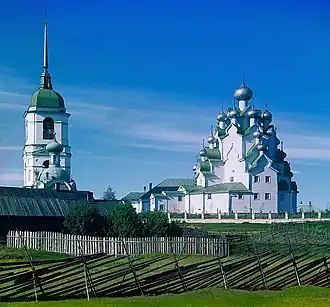Pogost

A pogost (Russian: погост) is a historical Russian term for an administrative-territorial unit. In modern Russian, it typically refers to a rural church and graveyard. It has also been borrowed into Latgalian (pogosts), Finnish (pogosta) and Latvian (pagasts), with specific meanings.
History
The term pogost originally denoted territorial centers, typically surrounded by numerous hamlets, that were used to receive dignitaries or guests, particularly in regions controlled by Novgorod.[1] These sometimes had paired churches.[1] The word pogost is similar to modern Russian gost' (гость, "guest"). It is assumed that originally pogosts were rural communities on the periphery, as well as trading centers (Old Russian: гостьба, gost'ba).[2]
The modern Russian term for a hamlet, derevnya, appears in historical sources from the 14th century.[3] In the territories of Smolensk and Novgorod, the term pogost was used to refer to a hamlet.[3] This could mean a hamlet, distinguished in modern Russian as pogost-mesto (погост – место), and a village center of a small area, known as pogost-tsentr.[3] The term could also be used to denote the surrounding area, known as pogost-okrug.[3]
From the 10th century, the term selo was used to refer to a village on the estate of a landowner.[3] By the 14th century, the terms selo and derevnya became interchangeable in the Russian North.[3] As Christianity continued to spread in Russia after its formal introduction in the late 10th century, the term selo came to refer to a village with a church, starting from the 16th century.[3]
In the Russian North, the pogost retained its status until 1775.[1] The term pogost came to be understood as a rural church and graveyard.[3] A pogost could have a freestanding bell tower positioned between and in front of two churches.[1] It could also be enclosed by a low wall constructed from horizontal logs resting on a fieldstone base, with square towers at the corners.[1] The most widely known example of the pogost, and Russian wooden architecture in general, is Kizhi Pogost on Kizhi Island in Lake Onega.[1]
Usage in Finland and Latvia
The central village of the Finnish kunta ('municipality') of Ilomantsi is usually called the pogosta of Ilomantsi (Ilomantsin pogosta), the word being obviously a borrowing from Russian. The local dialect of Finnish shows strong Russian influence, and there is a strong presence of Orthodox Christians in the municipality. Even the name of the local newspaper is Pogostan Sanomat ("The Pogosta News"), and a certain viral disease is locally called the Pogosta disease.
In the modern Finnish language, pogosta is also used in references to historical places, as a historical synonym for "parish" or "municipality" in Karelian, Ingrian and Russian contexts.
Pagasts is the name for a basic unit of local self-government in the Republic of Latvia. The word pagasts is a commonly used Latvian word equivalent to civil parish, rural municipality or small rural district, originating from Russian pogost. There are 432 rural municipalities or pagasti in Latvia.[4]
References
- ^ a b c d e f Brumfield 2025.
- ^ (in Russian) Большая энциклопедия русского языка
- ^ a b c d e f g h Postan 1966, p. 513.
- ^ "Latvian Association of Local and Regional Governments". Archived from the original on 2007-06-09. Retrieved 2007-06-09.
Sources
- Postan, M. M. (2 January 1966). The Cambridge Economic History of Europe from the Decline of the Roman Empire: Volume 1, Agrarian Life of the Middle Ages. Cambridge University Press. ISBN 978-0-521-04505-6.
- Brumfield, William Craft (2025). "The Russian North: Toward the White Sea". From Forest to Steppe: The Russian Art of Building in Wood. Duke University Press. pp. 117–239. ISBN 978-1-4780-2824-6.